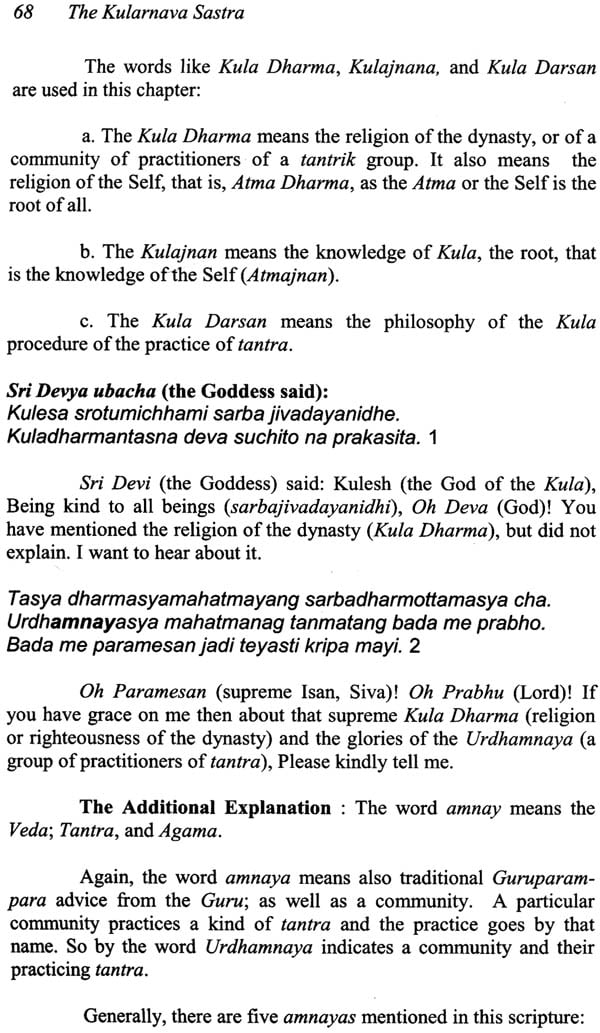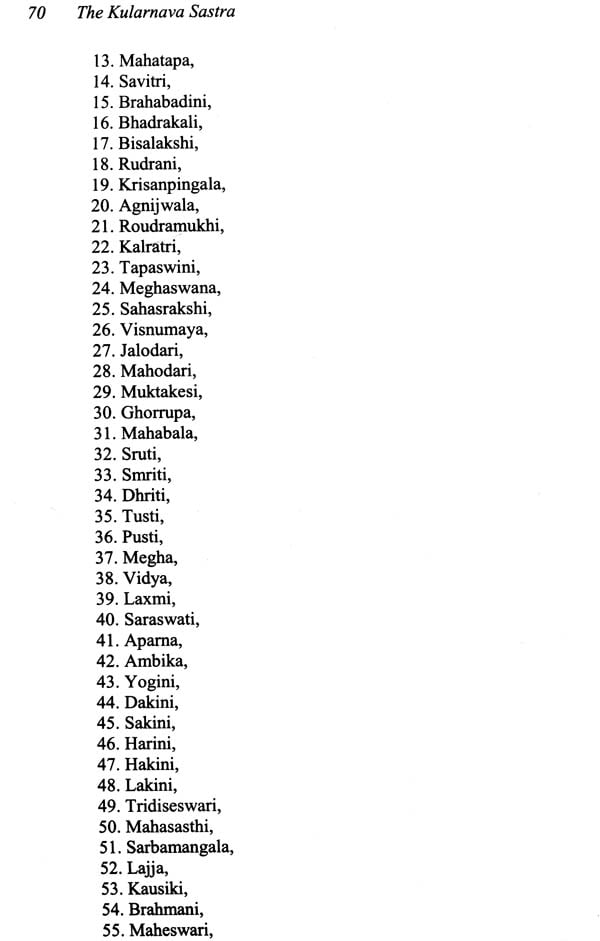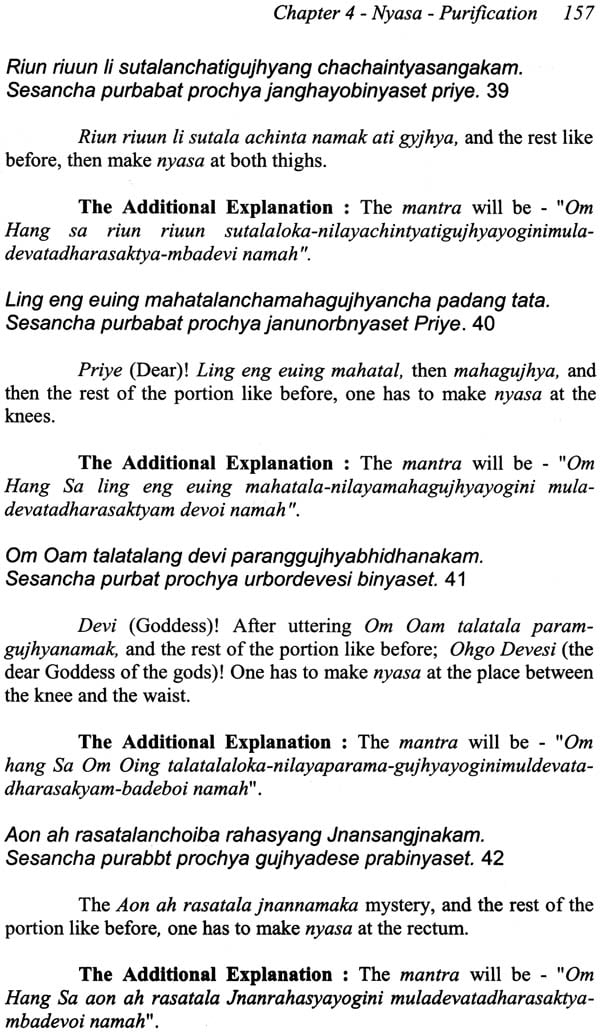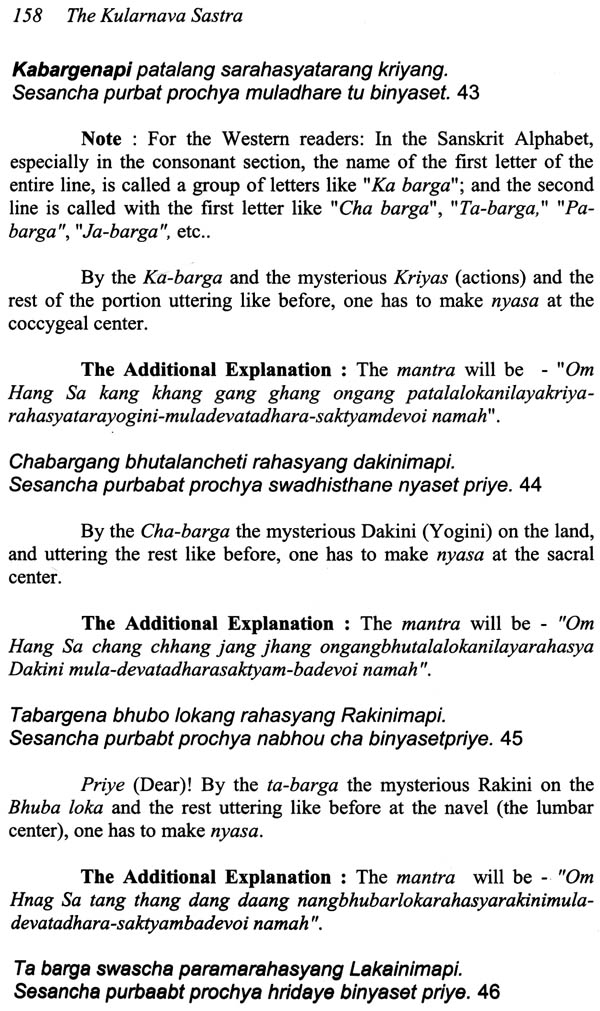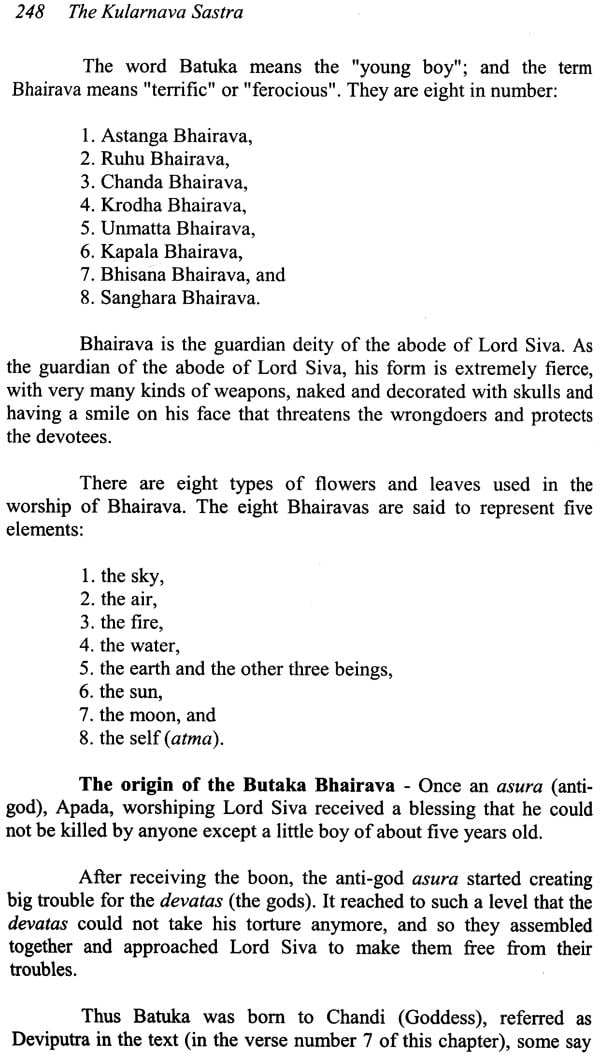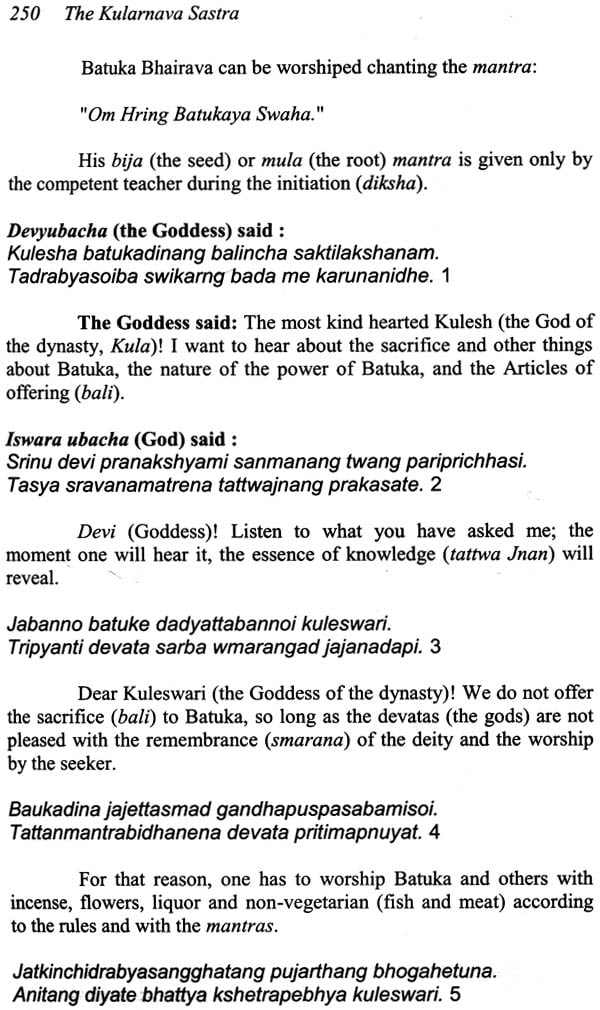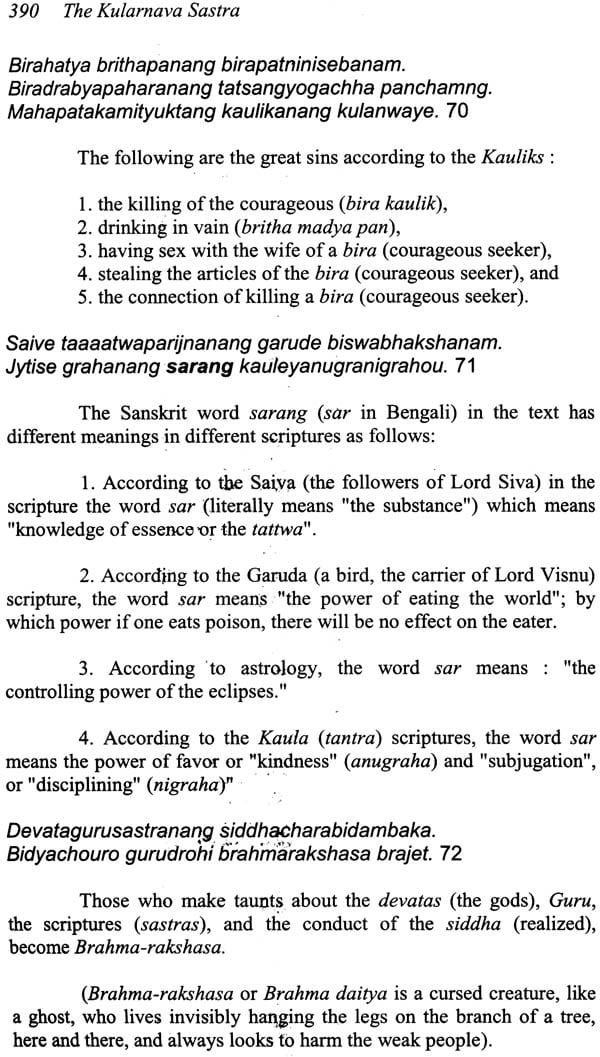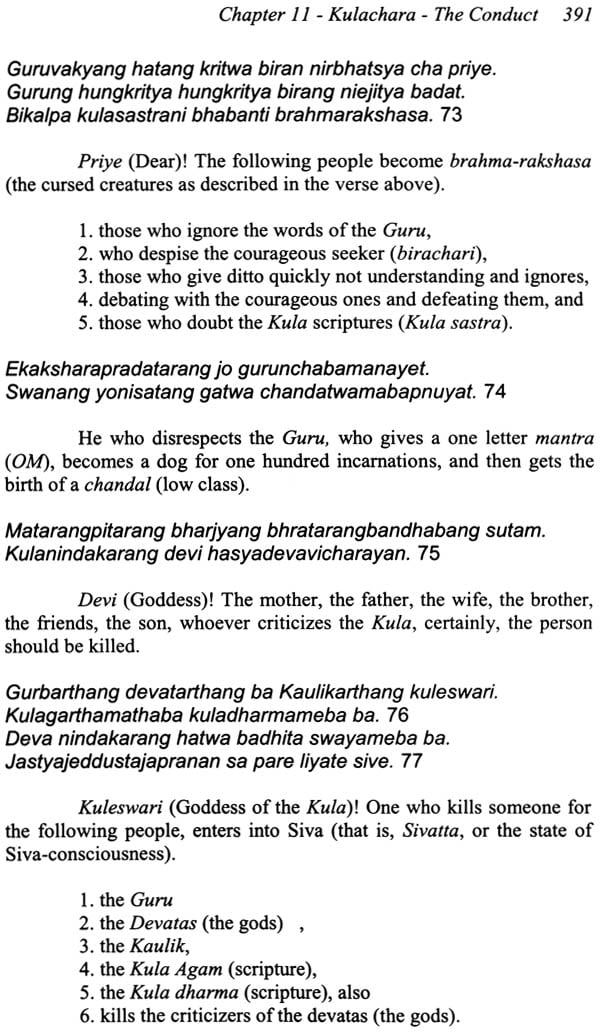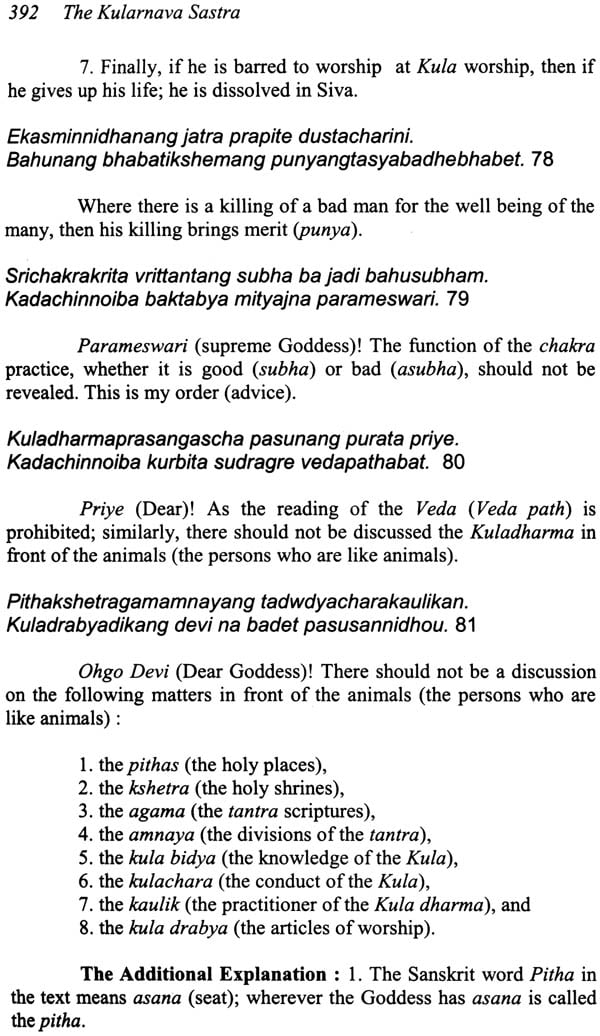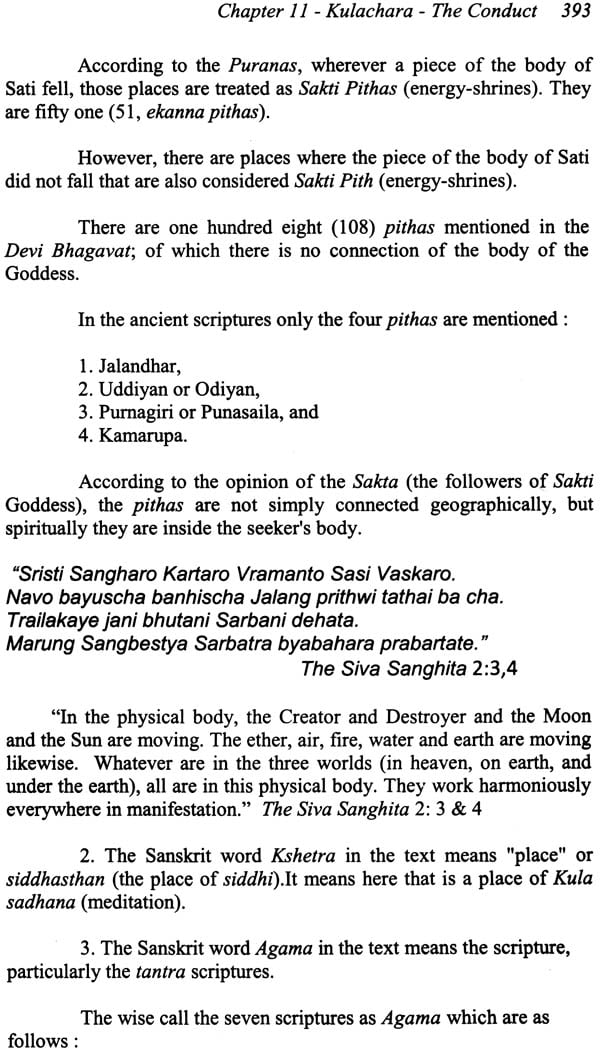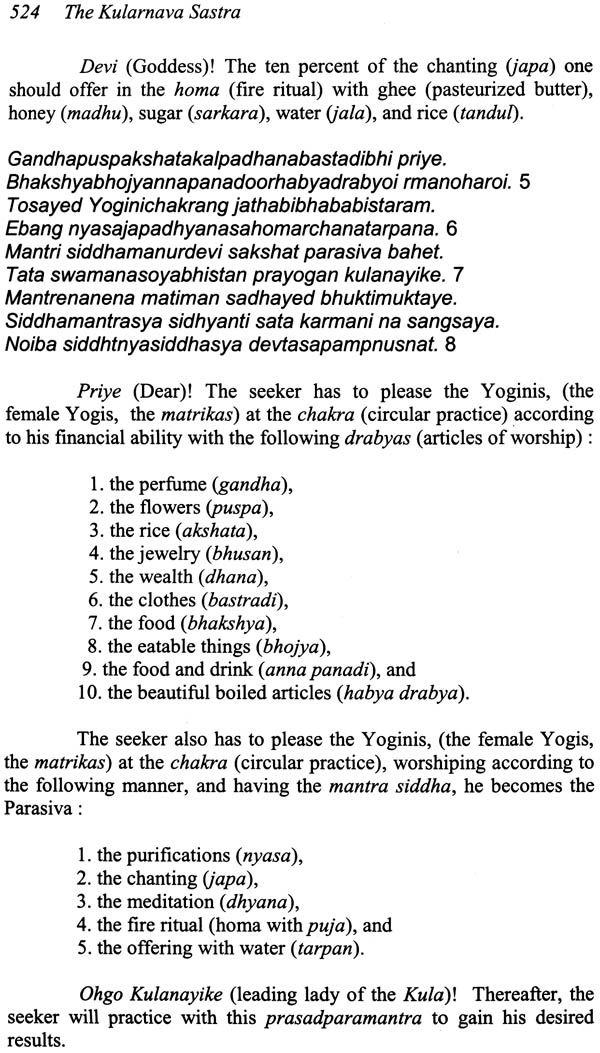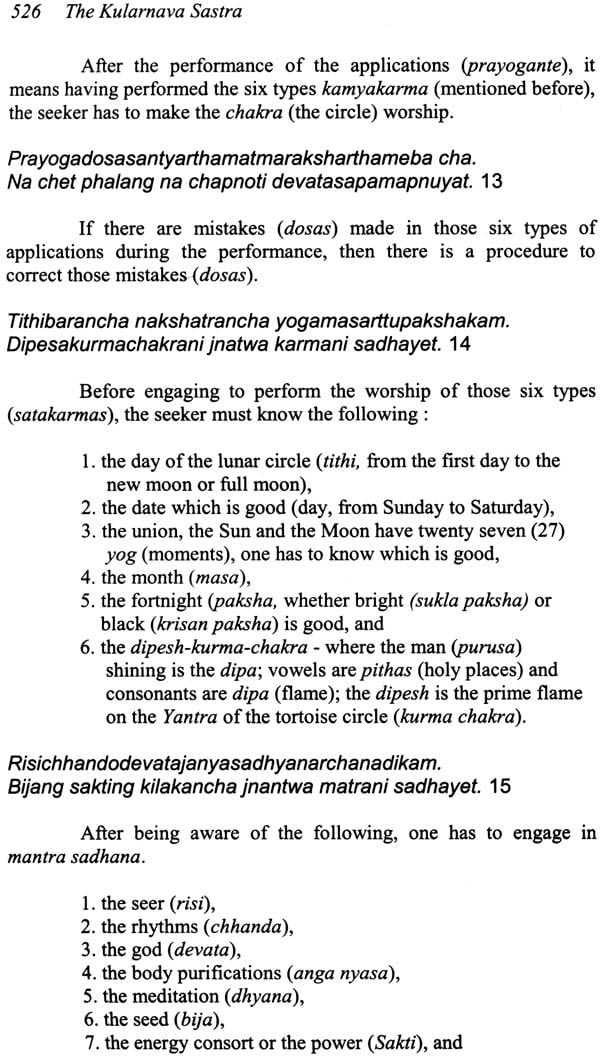
The Kularnava Sastra: For Both Bhukti (Enjoyment) and Mukti (Liberation)
Book Specification
| Item Code: | NAL948 |
| Author: | Swami Satyeswarananda Giri |
| Publisher: | The Sanskrit Classics, Publisher |
| Language: | Translated from the Original Sanskrit into English |
| Edition: | 2015 |
| ISBN: | 9781877854583 |
| Pages: | 600 |
| Cover: | Hardcover |
| Other Details | 8.5 inch X 5.5 inch |
| Weight | 780 gm |
Book Description
There are two types of Spiritual disciplines in the Aryya civilization in India.
1. Vedic, and
2. Tantrik.
Before we discuss about these two traditional disciplines, we have to clear something about the “secrecy” and the title of this book.
Importance of Secrecy:
Let us first strike at the unjustified and invalid liberal Western tendency of the international, commercial open market policy of the Eastern spiritual disciplines.
Bhabeddwviryati gupta nirvijya cha prakasita.
The verse says, “If the practice is kept secret then it becomes Viryavati (increases in power and strength), and if the (fruitless, devoid of power and Strength)”.
Therefore, in the best interest of the practitioner, he/she must keep the practice “secret”.
The kularnava Sastra [NOT Tantra]
Some people may raise the question as to why the title of the book is Kularnava Sastra. The answer is given by Lord Siva himself who characterized the message in the following verse.
Kularnavamidang Sastrang [NOT Tantra] is established in the heart of the Yoginis [the female yogis], I [Siva] just reveal it today [to Parvati]. It is necessary to keep it carefully secret.”
The First and the Foremost Path or Marga:
Aditwat sarbamarganang manollasaprabardhanant Jgyadidharmahetutwadamnaya iti kirtita.
This discipline is also the “prime (adi) of all paths”. It increases the joy of the mind, and it is th cause of the Jagyas (rituals); therefore, it is called Amnaya (scripture).
Lord Siva did not reveal this path before to his dear “wife” and most important people. He kept secret this path.
The Secretive Tradition and the Path:
Brahmavisnuguhadibhyo na maya kathitang pura.
Kathayami taba snehat srinusboikagramanasa.
Lord Siva admitted, saying, saying, “I have not spoken of this path, in past, to Brahma (creator), Visnu (preserver) and Kartikeya, [the eldest son of Siva, who is commander-in-chief of the devatas (gods)]. This Path was secret. To it very carefully”.
Vedasastrapuranani prakasyani kuleswari.
Soivasaktagama sarbe rahasya parikirtita.
Oh dear Kuleswari (the Goddess of the Kula)! The Veda, sastras (scriptures) and the Puranas are all revealed; but Saiva-Sakta (the Siva and Sakti, Energy, the Kundalini, the Agama sastras) are very secret, gujya.
Gujyad guiyatarang Devi sarang sarang parat param.
Sakshat Sivapradang Devi karnakarnigating kulam.
Oh dear Devi (Goddess)! Kula, that which is Kulachara (the conduct of the Kula), is the secrets; best among the best.
Siva assumes the “form of human being” from the Formless Pure Consciousness of the Self:
Sadhaktarakshanayoiba nirkaroyapi sakriti.
Siva kripanidhirloke sangsari hi chestate.
The verse says, “Kind Lord Siva being formless (nirajkara), to protect the true devotees assumes the form, and being a householder like the worldly human being behaves accordingly like the human being”.
Ataeba siva sakshat gururupang samasrita.
“Therefore, Ohgo Devi (Goddess)! 1 [the formless], Siva, assume the for Guru”.
Sivarupang samasthaya pujang grihnami parvati.
Gururupang samadaya bhabapasannikritantaye.
“Parvati! Assuming the form of “Siva”, I accept the worship of the devotees; and assuming the form of “Guru”, I cut the worldly attachments of the Jivas (the indivisual beings)”.
The Aryya Civilization in India:
As mentioned before, there are two types of spiritual disciplines in the Aryya Civilization.
1. Vedic, and
2. Tantrik
Let us see what are the differences and the similarities between the two traditions.
First, the Differences between the two traditions:
Generally speaking, the differences between the two disciplines are mainly two:
1. The Vedic follows the path of Renunciation (Nivritti).
2. On the other hand, the Tantrik follows the opposite of the Vedic renunciation. The tantric discipline aims at achieving the two:
a. the enjoyment (pravritti), and
b. the renunciation (nivritti).
In other words:
a.the bhoga (“enjoyment”). And
b.the Yoga (“liberation”).
Second, the Similarities between the two traditions:
The similarities between the two tradition are three. Primarily, the basic and the fundamental common grounds are three:
1. the seekers are “the masters of the senses” (Jitndriya).
2. the seekers are “householders”, and
3. the tantric seekers drink three tattwas or three sips of liquor, while the Vedic seekers try to overcome the influence of the three qualities (gubas).
The Additional Explanation – 1. The tantriks practing the bajroli mudra master the senses and become restrained (sangjata) and also become the winner of the senses (Jitendriya). The following verse indicates to this direction.
Ado rajah striya Yonya jatnena bidhibat sudhi.
Akuchya linganalena swasarire prabesayet.
The intelligebt seeker, first, very carefully and as per the tantric rules, (bidhibat) with the stem of the peins (linganal) attracts the liquid (rajah) from the vagina of the woman (stri-yoni-kuhar, that is, referred his text as rajah striya Yonya) into his body.
(Thus, he gains the strength of the winner of the senses, jitendriya), and never releases his sperm into the body of his Sakti. The Siva Sanghita, 2014 by the present author, P. 129).
This fact, the onlookers of the Vedic practitioners never see and know, and thus they fail to understand the “detachment” (jitendriya) aspect of the tantra practitioners.
2. The second “common group” or “similarity” is that the tantra discipline is practiced by the householder, both men and women.
3. The third commonality, according to the tantra tradition, the seeking drink three sips of liquor and overcome the influence of the very conception of the nature-born three qualities (gunas) of the Vedic tradition.
| 1 | Invocation (Mangalacharan) | v |
| 2 | Endowment in the University of Calcutta | vii |
| 3 | Dedication | ix |
| 4 | List of the Published Books | xiii |
| 5 | List of Illsutrations | xvi |
| The Kularnava Sastra | ||
| Introduction | 1 | |
| "Chapters" | ||
| 1 | Jiva - Individual Being | 39 |
| 2 | Kula Mahatmya - The Glories | 67 |
| 3 | MANTRA - Sri-PARA | 106 |
| 4 | Nyasa -Purification | 136 |
| 5 | Kula Dharma - Religion of the Dynasty | 183 |
| 6 | Purification of the Articls of Worship | 216 |
| 7 | Worship of Batuka | 246 |
| 8 | Drinking of the Three Tattwas (the Essences) | 278 |
| 9 | The Yoga | 314 |
| 10 | Worship on the Special Days | 345 |
| 11 | Kulachara - Conducting the Worship | 376 |
| 12 | Worship of Paduka - the Holy FEET | 401 |
| 13 | Guru-Sisya - The Master and Disciple | 426 |
| 14 | Test of Master and Disciple | 464 |
| 15 | Puraschaan - Preconditioned Activities | 488 |
| 16 | Kamya-Karma - DAILY Activities | 523 |
| 17 | Definitions of Certain Terms | 560 |

